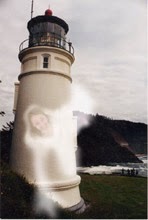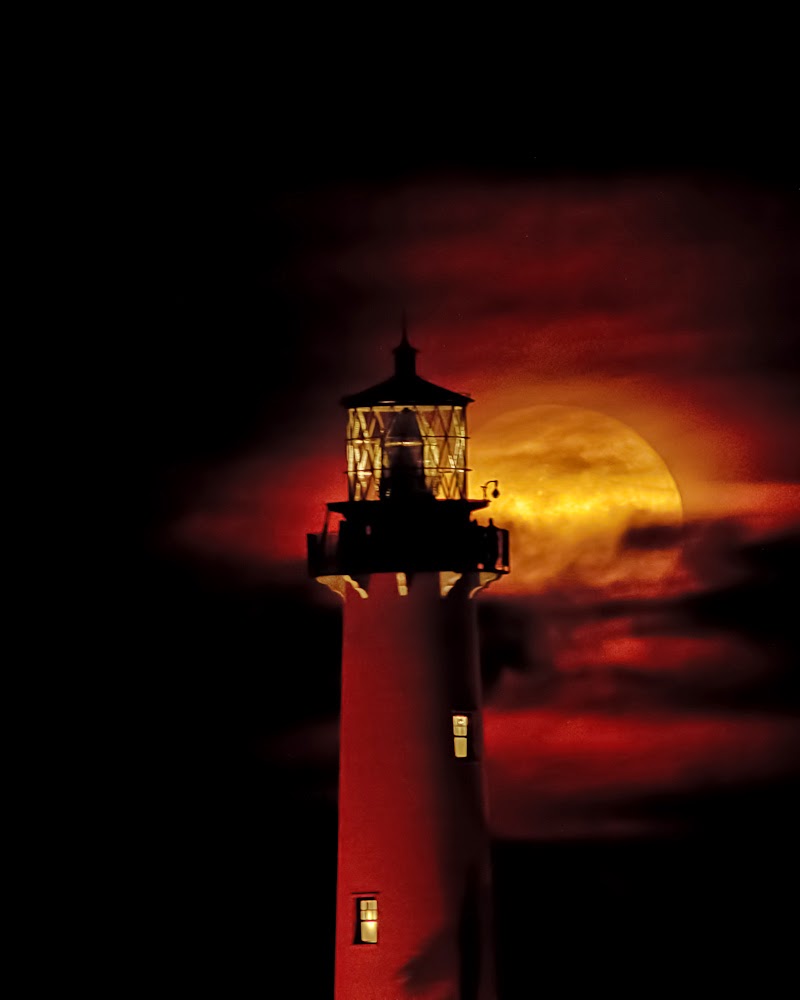Photo by Bruce Robie
****************************************
This time of year, I get emails and phone calls from friends telling me
they've seen me on TV—”Haunted Lighthouses.”
I’ve done two segments in this series with Impact TV, and it’s been a
lot fun. The crew was great, and we all got a laugh or two as we recreated the
sights and sounds of the best ghost tales from lighthouse lore. Viewer ratings
are always high when the shows air, and the calls and emails pour in. People love this kind of
stuff.
Lighthouses
lend themselves to supernatural tales. They’re mysterious—tall, dark,
hollow towers full of cobwebs, shadows, strange sounds, and odd smells.
Climbing a lighthouse at night can give you the creeps. Moist air moves up and
down the stairs, making mournful sighs. Sometimes it feels like a clammy hand
on the back of your neck! The sea moans and crashes nearby. And, of course,
there are tragic stories to recall of shipwreck, drowning, and storm damage.
It’s easy to understand why people think lighthouses are haunted.
Lightkeepers of yore claimed they met many lighthouse ghosts, and some of the
keepers wove some great yarns about them. Docents at lighthouses that are open
to the public continue the tradition. I’m the first to admit I’ve had some
eerie experiences at lighthouses, but I usually blame them on my overactive
imagination and natural phenomena I know can fool our senses. I’ll provide a few examples...
********************************
A young Coast Guard keeper took me to the top of Florida’s Jupiter
Lighthouse in the early 1980s. I asked him if the tower was haunted, and he
chuckled. “Only if you want it to be,” he quipped. I was taking notes on a clipboard as we
toured the lighthouse, and about three-quarters of the way up the
stairs I dropped my pen. It clanked and clinked and tapped and rapped on its
way down and through the open iron stairway, echoing as it went. I looked at the Coastie, and we both laughed. “Now
that sounded spooky!” he said. When I returned to ground level, there stood my
husband with the pen in his hand.
***************************************
In 1985, as my family was transferring from a military assignment in
Hawai’i to the submarine base at Groton, Connecticut, we drove the long route up the West Coast from Oakland to
Seattle and photographed lighthouses along the way before we turned east. On our third day up the coast, we stopped at
Newport, Oregon and Yaquina Bay Lighthouse. The docent was about to close up
for the day, but she kindly allowed me in to see the old lighthouse. My husband
and the kids took a stroll outside. They’d seen enough lighthouses!
I toured the downstairs rooms, which were furnished in the late nineteenth century period. There were a few displays in the rooms and a gift shop.
“May I go upstairs?” I asked the docent. She nodded but informed me I’d
be going alone.
“I don’t go up there. It’s the ghost, you know. I’ve seen her in the
upstairs rooms.”
I nodded sympathetically and commented that I hoped I wouldn't see a ghost.
“Be sure to look at the floor by the attic door. That dark stain is
blood. She died there—Muriel, I mean.”
I’d heard about Muriel. Her story is well-known in lighthouse history and in Newport.
She was with a group of young people messing around at the old, ramshackle
lighthouse in the late 1800s. The lighthouse was abandoned and an eyesore. The young folks
went inside, poked around—as teenagers will do--then left. Muriel announced
that she’d left her scarf inside the lighthouse and ran back for it. Minutes ticked by, and then a blood-curtling
scream was heard. The teens ran back inside and found a pool of blood upstairs
but no sign of Muriel. A thorough search was made of the lighthouse and the grounds, but she was never found.
Her disappearance remains a mystery today, except that…there happened to
be a dime novel circulating in the late nineteenth century with a very similar
plot. Most historians believe the story was repurposed for this yarn to amuse
tourists. It gained such popularity it remains a part of the
interpretation in the lighthouse museum today.
As for the docent who wouldn’t go upstairs, either she was an excellent
actor or she truly was afraid of the possibility of meeting a ghost. Stories can have that sort of
effect on people, especially when they're alone in an old building. I’ll admit that standing in the upstairs, with late afternoon
sunbeams pouring through the windows and reflecting off dust particles, and
everything so quiet and still...well....I could certainly imagine a young girl looking for her scarf,
searching in every corner, and then…tragedy.
I thanked the docent profusely for allowing me inside the lighthouse museum past closing hour
and bought some trinkets from the gift shop. Some twenty years later, I would
return to the lighthouse with Impact TV to talk about Muriel for a documentary
on haunted lighthouses.
*********************************************
I visited New London Ledge Lighthouse in the late 1980s as it was being
automated and sealed up. There were still five Coast Guardsmen stationed on the
lighthouse, three of them there when I visited and two on leave. Ledge Lighthouse has a
famous ghost named Ernie, supposedly a former keeper who threw himself off the
top of the tower after he discovered his wife was having a romance with a
harbor pilot. No one has ever been able to authenticate the story, and records for the lighthouse do not indicate there was ever a suicide. But plenty of people have reported the ghost. He was given the
name Ernie for fun, since he's a bit of a trickster.
The Coasties were ultra-eager to help me up from the pitching boat next
to the slimy, alga-covered stairs on the side of the lighthouse. It’s a caisson
lighthouse that sits on a rock ledge in the middle of the Thames River in New
London, Connecticut. It was a stag station in its last years of staffing—men only.
So a visit from a lady was a big deal. With me on the boat was Brae Rafferty of Prjoect Oceanology
at Avery Point. We were both interested in what would happen to the lighthouse after automation.
The guys were happy to show us around the station and offered us coffee
and peanut butter sandwiches. We declined both but asked if we could climb to
the lantern and take in the view. As we headed up the stairs, the OIC reminded us to "watch out for Ernie," tongue in cheek of course. It was a cold day, but the lantern
was warm. It was also quiet—its own little world looking out over the harbor.
The ferry from Orient Point passed by. Some small fishing boats were bouncing
about in the chop farther out in Long Island Sound. Flies buzzed in the windows,
wondering how they’d become prisoners in the lantern.
We stepped carefully out on the gallery, and I peered down at the water
below. The lighthouse seemed to grow upwards from the water. The wind was
fierce, lifted my hair and whirring loudly around the edges of the tower.
“So Ernie jumped from here?” I asked Brae.
He nodded and chuckled. “That’s what I’ve heard.”
I softly called Ernie’s name. "Errrrrnie...where are you?" Brae joined me, smiling. We were having fun, of
course, but then the access door to the gallery banged in the wind and we both
jolted.
“I think he’s trying to lock us out! I said.
“Well, then we’d better get back inside before he succeeds!” Brae added.
Down in the warm kitchen, the Coasties all related tales of encounters
with Ernie. One man said Ernie tried to smother him with a pillow one night.
Another claimed Ernie purloined tools, drank coffee from cups sitting on the
counter, and rearranged the books on the shelf.
“He’s real alright,” the OIC said, “…if you want him to be.”
A few weeks later I was invited to appear on a local TV program and talk
about the lighthouse. I gave a bit of history, discussed the automation that
had taken place, and then I was asked to talk about Ernie. Viewers called in
with questions and comments, and all of the talk was about the ghost. People were much more interested in the ghost of the lighthouse than its flesh and blood occupants of the past.
****************************************
usatoday.com
One night in the mid-90s I climbed to the top of Ponce Inlet Lighthouse
at Daytona, Florida with the late Tom Taylor, one of the founders of the
Florida Lighthouse Association. There was a night rocket launch scheduled at
Cape Canaveral, and Tom told me the top of the lighthouse was a great place to
view it. As we sat on the lantern talking and enjoying the cool breeze and the night
sky, groaning, screeching sounds began. They sounded like some sad, sick
spirit. Arrrgggh! My eyes widened. Tom laughed and told me the stairway was the
cause. It was cooling down from the hot day, and its metal joints were
contracting, making the groaning and screeching sounds. Even though I knew the source of
the clamor, it was still quite unsettling to hear.
******************************************

In February 2005, I stayed for a week at New Dungeness Light Station in Sequim, Washington to
serve as a keeper. I had four co-keepers, two couples from the area. They voted
to give me the bedroom that faced the lighthouse, since they had slept there on
past stints of duty as keepers. It was exciting to lie in bed and see the beams
of the lighthouse whirling around in the misty air. In fact, it was downright
mesmerizing. Killdeer flew madly at the beams, streaking through the humid air
like kamikazes. As I lay under the blankets enjoying this odd scene, a bright light flashed
on my bedroom window, crawled onto the wall, and flickered wildly before vanishing. I jumped out of bed and went to the window in time to see
the light return again, strafing the house and shining on all the windows. It paused on my window and seemed to study my silhouette. This reminded
me of a sci-fi movie where a spaceship hovers overhead and shines a
bright light down on unsuspecting citizens of earth! Soon, I identified the
source of the light. It was a fishing boat some distance off the sand spit. The
fishermen were having some fun shining lights on bedroom windows!
**************************************

I stayed in the B&B at Heceta Head Lighthouse a few years ago to celebrate
my friend’s birthday. All evening, we sipped tea and told stories. Naturally,
it being September, the story-telling turned to the quickening seasonal
darkness and ghosts. Heceta Head Light Station is famous for its ghosts, namely
the Gray Lady, also called Rue. Supposedly, she is the sad spirit of a long-ago
keeper’s wife whose child died. The innkeepers say she’s searching for the
little girl, who sometimes appears herself. Rue has been seen in the attic
window, in the upstairs of the house, and on the grounds. Dozens of
visitors to the inn have reported her eerie activities, including moving
objects around and pilfering things like jewelry and cosmetics. During my stay,
the scary tales flowed like the steamy tea from its china pot! My daughter had
made tea for all of us and accidentally burned her hand in the process. After we
went to bed, her hand was hurting so bad she told me she was going down to the kitchen
to fetch a Ziplock bag of ice to soothe it. We were sharing a bed, and shortly after
she left for the kitchen, I heard a soft scratching at the door, which was open
a crack and let in the hallway light. Then the door creaked softly and opened a
bit more, I waited, lying very still.
“Jessica, is that you?” I asked.
No
answer. More scratching, and a little soft thumping too.
Seconds later, something
landed on the bed at my feet. I gasped and drew my feet away from it.
Whatever it was, I had frightened it and it bolted from the room. A few seconds later I heard scratching
again. Then quiet footsteps and whispers. Jessica appeared at the door.
“Mom,
do you think it would be okay to let Dawn in our room to sleep with us? I think she's lonely.”
Dawn was one of
the inn’s many cats. It was her little paws I had heard scratching and thumping,
and Jessica’s footsteps and whispers.
************************************
I learned of a lighthouse ghost cat during a phone interview in the
early 1990s. The charming little spirit ended up in several of my books and articles—no
surprise, since I am a cat lover. Pamela Brent, curator of Ohio’s Fairport
Harbor Light, was living in the apartment above the museum in the old keeper’s
dwelling at the time. We talked about the lighthouse by phone. Brent told me the dwelling's upstairs
apartment has a ghost kitten that skitters about the floors and hallway. She had seen it herself. It was a friendly little ghost, a fun one.
It looked like a little puff of gray smoke moving over the floor. Brent said it
had a sweet face with very bright eyes.
When you visit the lighthouse museum, docents will show you a desiccated cat
skeleton that was found in a wall when repairs were done to the dwelling years
ago. (See image below.) Brent believes it’s the remains of a kitten belonging to a nineteenth century keeper's
sick wife, a kitten that accidentally was walled in by workers. (Let’s hope it
was an accident!) The little kitty provided amusement for the keeper’s
ill wife who was bedridden for many weeks. There’s also a ghost of a little
boy at Fairport Harbor Light. He’s thought to be one of the same keeper's children
who died at about age five.
Fairport Harbor Historical Society
*******************************************
Whether
you believe in ghosts or not, a good place to go looking for them might be a
lighthouse!
October is great time to tell ghost tales, so if you volunteer or work
for a lighthouse nonprofit, consider having a haunted lighthouse event. It can raise awareness about the lighthouse, bring in revenue, and entertain the public. A few spider
webs at the windows, someone in a sheet, a carefully timed groan or two—-and
you’ve got delightfully frightened visitors. Not a bad thing, really.
How about
a trick-or-treat night at the lighthouse? Station some “characters” at various
places around your lighthouse to hand out candy to kids in costume—the oil house,
the keeper’s house porch, the base of the tower, and the lantern. Kids don’t
forget fun like this and will come back to visit when they are adults and maybe
bring their kids too.

_water_waves__1dlUgI0GQS.jpg)















105b%2BStandard%2Be-mail%2Bview.jpg)




















